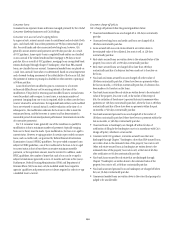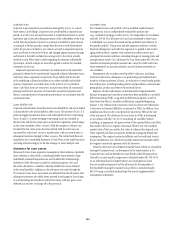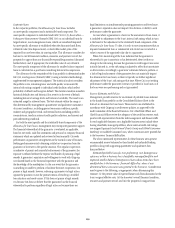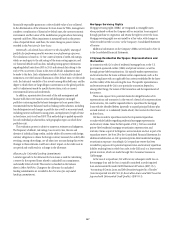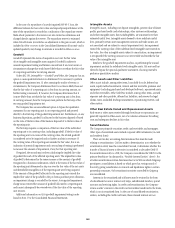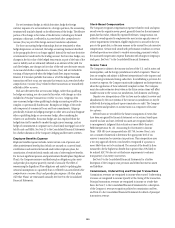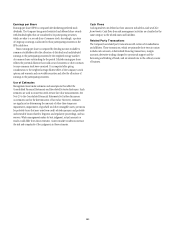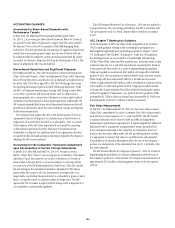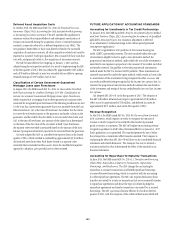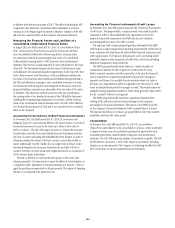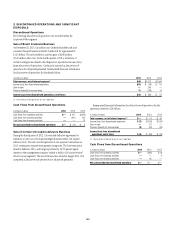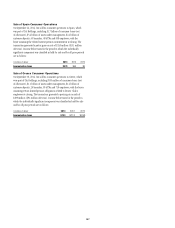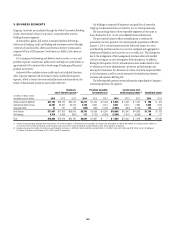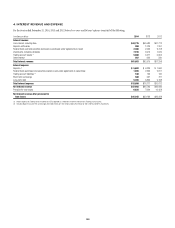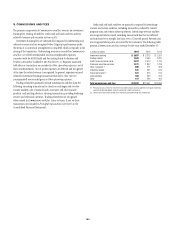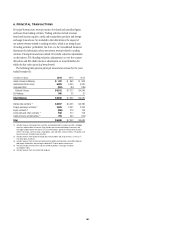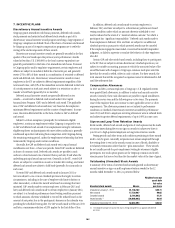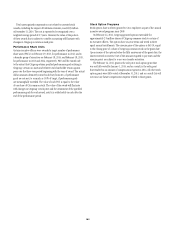Citibank 2014 Annual Report Download - page 170
Download and view the complete annual report
Please find page 170 of the 2014 Citibank annual report below. You can navigate through the pages in the report by either clicking on the pages listed below, or by using the keyword search tool below to find specific information within the annual report.153
Deferred Asset Acquisition Costs
In October 2010, the FASB issued ASU No. 2010-26, Financial Services-
Insurance (Topic 944): Accounting for Costs Associated with Acquiring
or Renewing Insurance Contracts. The ASU amended the guidance for
insurance entities that required deferral and subsequent amortization of
certain costs incurred during the acquisition of new or renewed insurance
contracts, commonly referred to as deferred acquisition costs (DAC). The
new guidance limited DAC to those costs directly related to the successful
acquisition of insurance contracts; all other acquisition-related costs must be
expensed as incurred. Under prior guidance, DAC consisted of those costs that
vary with, and primarily relate to, the acquisition of insurance contracts.
The ASU became effective for Citigroup on January 1, 2012 and was
adopted using the retrospective method. As a result of implementing the ASU,
in the first quarter of 2012, DAC was reduced by approximately $165 million
and a $58 million deferred tax asset was recorded with an offset to opening
retained earnings of $107 million (net of tax).
Classification of Certain Government-Guaranteed
Mortgage Loans upon Foreclosure
In August 2014, the FASB issued ASU No. 2014-14, Receivables-Troubled
Debt Restructuring by Creditors (Subtopic 310-40): Classification of
Certain Government-Guaranteed Mortgage Loans upon Foreclosure,
which requires that a mortgage loan be derecognized and a separate other
receivable be recognized upon foreclosure if the following conditions are met:
(i) the loan has a government guarantee that is not separable from the loan
before foreclosure; (ii) at the time of foreclosure, the creditor has the intent
to convey the real estate property to the guarantor and make a claim on the
guarantee, and the creditor has the ability to recover under that claim; and
(iii) at the time of foreclosure, any amount of the claim that is determined
on the basis of the fair value of the real estate is fixed. Upon foreclosure,
the separate other receivable is measured based on the amount of the loan
balance (principal and interest) expected to be recovered from the guarantor.
Citi early adopted the ASU on a modified retrospective basis in the fourth
quarter of 2014, which resulted in reclassifying approximately $130 million
of foreclosed assets from Other Real Estate Owned to a separate other
receivable that is included in Other assets. Given the modified retrospective
approach to adoption, prior periods have not been restated.
FUTURE APPLICATION OF ACCOUNTING STANDARDS
Accounting for Investments in Tax Credit Partnerships
In January 2014, the FASB issued ASU 2014-01, Investments-Equity Method
and Joint Ventures (Topic 323): Accounting for Investments in Qualified
Affordable Housing Projects. Any transition adjustment is reflected
as an adjustment to retained earnings in the earliest period presented
(retrospective application).
The ASU is applicable to Citi’s portfolio of low income housing tax
credit (LIHTC) partnership interests. The new standard widens the scope
of investments eligible to elect to apply a new alternative method, the
proportional amortization method, under which the cost of the investment is
amortized to tax expense in proportion to the amount of tax credits and other
tax benefits received. Citi qualifies to elect the proportional amortization
method under the ASU for its entire LIHTC portfolio. These investments are
currently accounted for under the equity method, which results in losses (due
to amortization of the investment) being recognized in Other revenue and
tax credits and benefits being recognized in the Income tax expense line. In
contrast, the proportional amortization method combines the amortization
of the investment and receipt of the tax credits/benefits into one line, Income
tax expense.
Citi adopted ASU 2014-01 in the first quarter of 2015. The adoption of
this ASU will reduce Retained earnings by approximately $349 million,
Other assets by approximately $178 million, and deferred tax assets by
approximately $171 million, each in the first quarter of 2015.
Revenue Recognition
In May 2014, the FASB issued ASU No. 2014-09, Revenue from Contracts
with Customers, which requires an entity to recognize the amount of
revenue to which it expects to be entitled for the transfer of promised
goods or services to customers. The ASU will replace most existing revenue
recognition guidance in GAAP when it becomes effective on January 1, 2017.
Early application is not permitted. The standard permits the use of either
the retrospective or cumulative effect transition method. The Company is
evaluating the effect that ASU 2014-09 will have on its consolidated financial
statements and related disclosures. The Company has not yet selected a
transition method nor has it determined the effect of the standard on its
financial statements.
Accounting for Repurchase-to-Maturity Transactions
In June 2014, the FASB issued ASU No. 2014-11, Transfers and Servicing
(Topic 860): Repurchase-to-Maturity Transactions, Repurchase
Financings, and Disclosures. The ASU changes the accounting for
repurchase-to-maturity transactions and linked repurchase financings
to secured borrowed accounting, which is consistent with the accounting
for other repurchase agreements. The ASU also requires disclosures about
transfers accounted for as sales in transactions that are economically similar
to repurchase agreements and about the types of collateral pledged in
repurchase agreements and similar transactions accounted for as secured
borrowings. The ASU’s provisions became effective for Citi from the first
quarter of 2015, with the exception of the collateral disclosures which will



